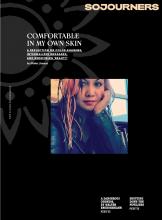MY EXPERIENCE BEING color-shamed began when I was 5 years old and still living in the Philippines. My mom and aunts often told me that I could be mistaken for “the maid’s daughter,” due to my darker brown skin. Even at a young age, I understood it was intended as an insult.
As I grew up, billboards, films, television shows, and magazines bombarded me with images of white Americans and Filipinas with white facial features. Mestiza Filipina models and actresses—celebrities admired by young girls like me—advertised skin-whitening products.
Color-shaming by other Filipinas continued after I moved to the United States at age 7. My mom, titas (aunts or older women), and lolas (grandmothers or elderly women) told me to “stay away from the sun” and “try not to get so dark.” They told me I would look even prettier if I had lighter skin.
This skin color hierarchy didn’t come just from other Filipinos. In junior high a boy I liked told my friend I was “too brown for his taste.” A white woman once asked my white boyfriend what he saw in me, a “brown chick.” When I was 27, I walked into a restaurant and a white lady told her friends, “Let’s get out of here. It’s getting too brown up in here.” Others have suggested I marry a white man instead of a Filipino so I can make “pretty light-skinned babies.” Not to mention the mostly white faces of U.S. mainstream media.
Beauty Erasers
IN Doing Christian Ethics from the Margins, theologian Miguel A. De La Torre describes how dominant cultures view oppressed peoples as objects. But the problem runs deeper, explains De La Torre: “Persons viewed as objects accept their oppressors’ worldview as their own,” he writes, and “often feel compelled to behave and act according to the way in which they have been constructed by others.”
While colorist and racist comments pained me deeply, it had not occurred to me how I had internalized these messages of brown-skin inferiority. And yet, I had: As a teen I used toxic chemicals to bleach my hair blonde, wore blue contacts, pinched my nose every night to form it thinner, and purchased shades of foundation lighter than my own skin tone. More recently, I highlighted my hair light brown and bought contour makeup to give the illusion of having white facial features: a thinner and pointier nose, higher cheekbones, a more chiseled bone structure. The more I looked like the white models and actresses on my Pinterest page, the more confident I felt.
If someone had asked me why I dyed my hair or wore so much makeup, I would have said it was my personal preference; I would not have attributed it to the constant stream of images promoting white beauty standards in the U.S and the Philippines. I did not realize I was conditioned to want to look white.
Read the Full Article

